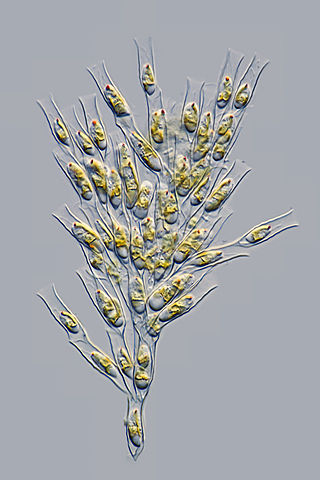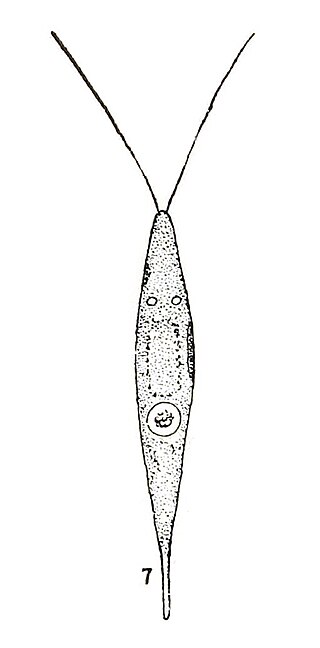
The Chrysophyceae, usually called chrysophytes, chrysomonads, golden-brown algae or golden algae, are a large group of algae, found mostly in freshwater. Golden algae is also commonly used to refer to a single species, Prymnesium parvum, which causes fish kills.
In biology, a homonym is a name for a taxon that is identical in spelling to another such name, that belongs to a different taxon.

Naso elegans, the elegant unicornfish, the blonde naso tang, Indian orange-spine unicorn, lipstick surgeonfish, lipstick tang, orangespine unicornfish or smoothheaded unicornfish, is a species of marine ray-finned fish belonging to the family Acanthuridae, the surgeonfishes, unicornfishes and tangs. This species is found in the Indian and western Pacific Oceans.

Chaetophora elegans is the type species in the algae genus Chaetophora.

Gibbonsia elegans, the spotted kelpfish, is a species of clinid native to subtropical waters of the Pacific Ocean from central California, U.S. to southern Baja California, Mexico. It prefers subtidal rocky habitats with seaweed down to a depth of about 56 metres (184 ft). This species can reach a maximum length of 16 centimetres (6.3 in) TL. This species feeds on benthic crustaceans, gastropods, and polychaete worms. The genus Gibbonsia is named after William P. Gibbons who was a naturalist in the California Academy of Science. It is found in three different colors depending on their habitat. Males and females do not show sexual dimorphism.

Pocillopora is a genus of stony corals in the family Pocilloporidae occurring in the Pacific and Indian Oceans. They are commonly called cauliflower corals and brush corals.
Gongolaria elegans is a species of brown algae in the family Sargassaceae endemic to the Mediterranean.

Draconichthys elegans a selenosteid arthrodire placoderm from the Late Frasnian Kellwasserkalk facies of the Anti-Atlas Mountains of what is now Morocco. During the Late Devonian, the region would have been a shallow, algae-dimmed sea.
Chondracanthus elegans is a red algae species in the genus Chondracanthus. The name elegans is Latin for 'elegant.'

Chlorogonium elegans is a species of freshwater green algae in the family Haematococcaceae.
Cyanonephron elegans is a freshwater species of cyanobacteria in the family Synechococcaceae. It is described in the Netherlands, Siberia, Russia and Queensland, Australia.
Chromulina is a genus of golden algae in the family Chromulinaceae.
Cymbodinium elegans is a species of marine dinoflagellates in the order Noctilucales. It is the only species in its genus.
Pyrobotrys elegans is a species of green algae in the family Spondylomoraceae.

Acrochaetium is a genus of marine red alga.
Colaconema elegans is a species of marine red algae. It is found in Korea, California and Brazil. It is parasitic in the stipe of Eisenia arborea.
Spirogyra elegans is a species of green algae in the family Zygnemataceae.
Cruoriella elegans is a species of red algae in the family Peyssonneliaceae. It is found in the southern islands of Japan.

Kyphosus elegans, the Chopa Mojonera or Cortez chub, is a species of marine ray-finned fish, a sea chub from the family Kyphosidae. It is found in the eastern Pacific Ocean where it is of minor importance to commercial fisheries.

Feeder shrimp, ghost shrimp, glass shrimp, grass shrimp, river shrimp or feeder prawns are generic names applied to inexpensive small, typically with a length of 1 to 3 cm, semi-transparent crustaceans commonly sold and fed as live prey to larger more aggressive fishes kept in aquariums.









